Celebrate! A Spring High Flow Experiment in Grand Canyon
Last week, the Bureau of Reclamation announced the authorization of a spring High Flow Experiment (HFE) in the Grand Canyon. This is a big deal.
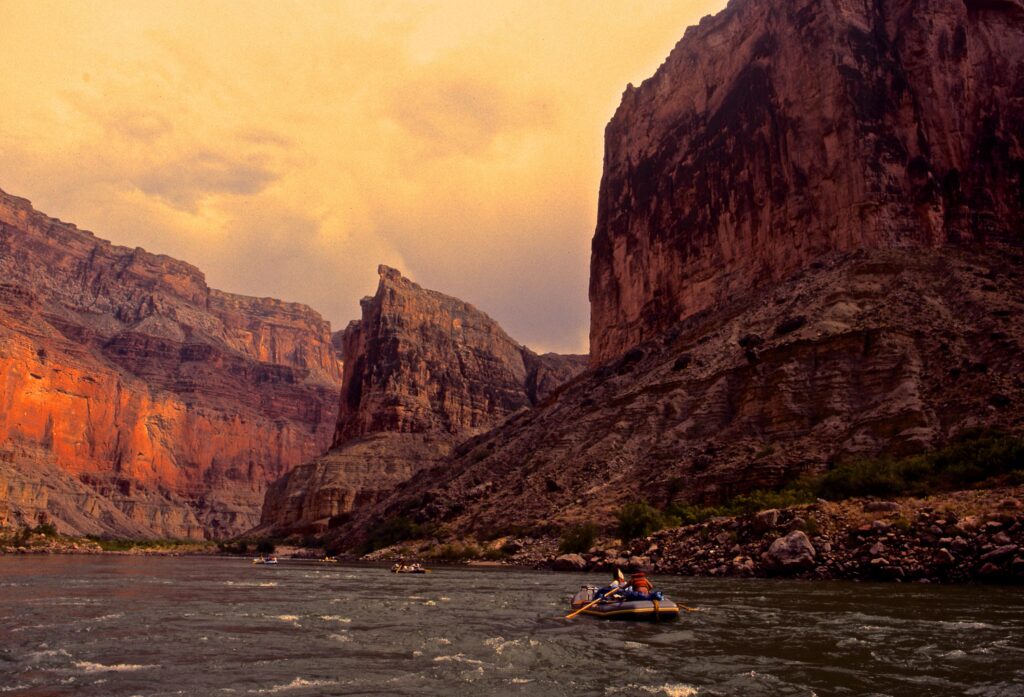
Last week, the Bureau of Reclamation, the federal government agency that oversees and manages operations on the Colorado River, announced the authorization of a spring High Flow Experiment (HFE) in the Grand Canyon. This is a big deal since the last time an HFE was conducted was in the fall of 2018, and the last time a spring HFE was executed was in 2008. And with the Colorado River in the Grand Canyon named as America’s Most Endangered River® just last week, we are thrilled that this action is happening to benefit the ecosystem in the canyon.
What is an HFE?
A High Flow Experiment is in essence a simulated flood being conducted through Glen Canyon dam. In practice, the dam releases a high volume of water, usually through both the hydropower turbines and the bypass tubes, which are lower-elevation tubes through the dam that are usually only used for these short duration floods or in other unique situations (like releasing water during the extreme inflows of 1983) over a limited period of time. HFE’s are extremely important to the management of sand in the canyon and the healthy functioning of the Grand Canyon riparian ecosystem overall.
To set the stage even further, let’s go back to the time before the creation of Glen Canyon Dam. The Colorado River traditionally carried millions and millions of tons of sediment down the river each year. Since Glen Canyon was built, most of that sand has been trapped in the upper reaches of Lake Powell – as flows slow down as the river becomes the lake, the sediment drops out and settles (up near Hite and Halls Crossing and then the San Juan as it enters the lake as well.) The result is that the water coming through Glen Canyon dam is very clear, lacking the traditional sediment that would be carried by the river and maintaining beaches and sandbars and the natural ecological benefits of that silty, sediment-laden water throughout the canyon. This clear water erodes sand from beaches and sandbars, and for decades in the 1970’s and 1980’s was causing real problems with the canyon’s ecology. In the 1990’s and early 2000’s, some experiments were conducted to begin to learn how these floods might act and how they might contribute to sand and other ecological functions within the canyon. Then, in 2016, the Long Term Experimental and Management Plan (LTEMP) was completed and set the guidelines for how and how frequently future HFE’s could be conducted.
Now, the Paria River, which is about 17 miles downstream from Glen Canyon dam (and about a mile below the put-in at Lee’s Ferry) is the main source of sediment into the Grand Canyon. When the Paria River flashes (most commonly during the summer monsoon season) it can deposit tons of sand – sometimes more than a million tons of sand – in a summer. This sand is what can be pushed downstream in an HFE to rebuild beaches and sandbars, and aid in the protection of cultural resources throughout the length of the canyon.
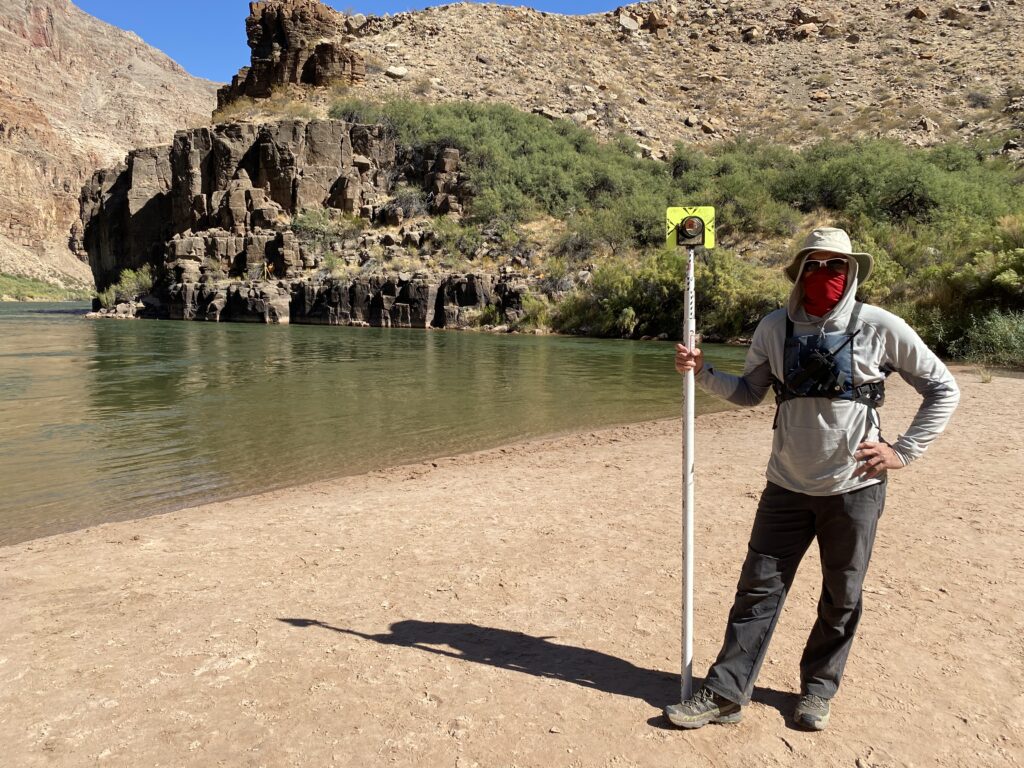
One of the elements within these LTEMP guidelines is how and when these HFE’s may be conducted, and how often the program should try to make them happen. Sadly, they have not happened often enough, and the canyon is really suffering because of it. Since the last HFE in 2018, there have been complications with declining water levels across the basin but felt most acutely in Lake Powell as elevations have declined to record lows. Then in 2021 and 2022, the monsoons delivered abundant sand through the Paria into the Colorado River, but unfortunately also caused a lot of erosion of beaches downstream as these monsoon storms ripped across Grand Canyon and the Colorado Plateau.
Today, we are celebrating the decision by the Bureau of Reclamation to use this opportunity to trigger one of these HFE’s to move the volume of sand currently sitting near the mouth of the Paria to rebuild beaches and sandbars, repair the ecology, and aid the protection of cultural resources downstream.
Credit: Justin Clifton and Blake McCord, Sandcast Media
Reclamation was able to make this decision based on several factors. First, due to the drought operations conducted over the past two years, there is a good amount of water parked in Lake Powell to protect the hydropower infrastructure at Glen Canyon dam that had to be moved downstream sometime this year. Second, the sand is there and the damage to the beaches in the canyon is glaring. Third, the water sitting in Lake Powell right near the dam (in an area above the dam called the “forebay”) is quite cold, which could aid aquatic species downstream. And lastly, there is a window of time where Reclamation and the hydropower providers can shift the timing of some needed maintenance at the dam to free up the opportunity to have all 8 hydropower penstocks and some of the bypass tubes available to actually conduct the high flows through the dam.
This week’s HFE will be pretty dramatic, both visually and scientifically. The flow will begin early Monday morning (April 24) and last into Thursday evening (April 27.) The dam will ramp up releases to 39,500 cubic feet per second (CFS) and hold that for 72 hours straight creating a flood that will flow all the way to Lake Mead over a period of about a week, rebuilding sandbars and beaches along the way (and giving rafters in the canyon an exciting ride!) One additional key point to understand is that HFE’s consume no net loss of water in Lake Powell – after the HFE occurs, Glen Canyon dam will release slightly less water than normal over a period of weeks, in order to make up that amount of water that is shot downstream, yet another benefit in the design in these critically important High Flow Experiments.
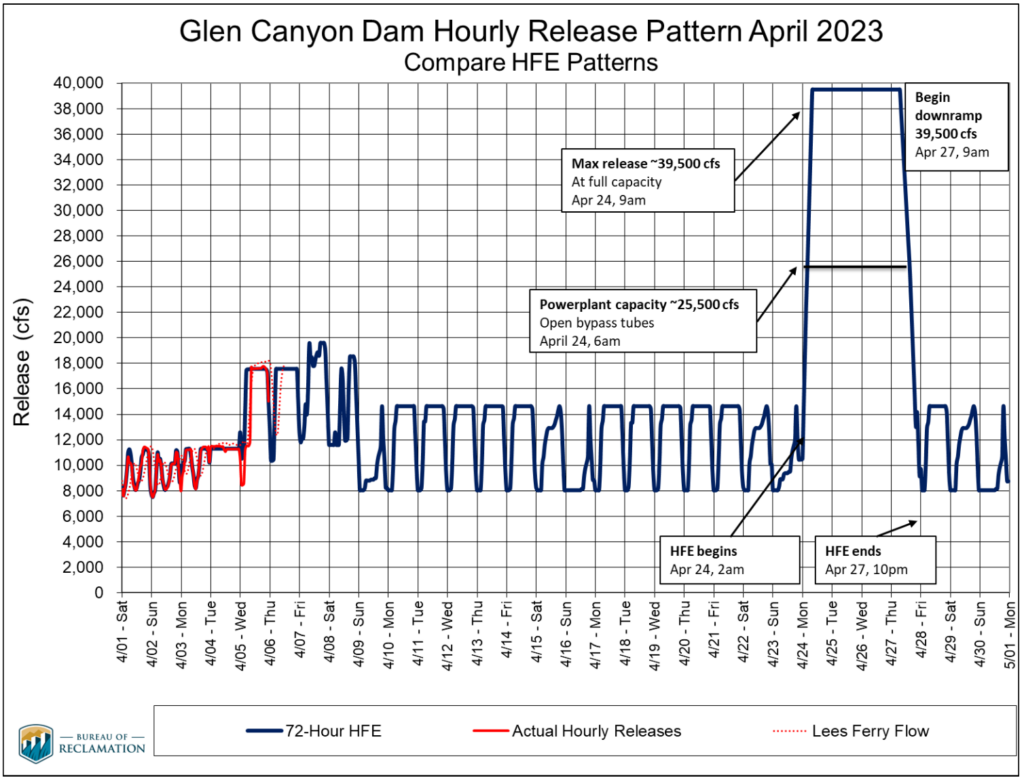
Again, we applaud the Bureau of Reclamation, the scientists at USGS’ Grand Canyon Monitoring and Research Center, and everyone else who has been working hard to make one of these HFE’s happen for years. We are looking forward to seeing the great results that will come out of this event very soon.
(To learn more about the Grand Canyon’s history and ecosystem, check out our new story map, Caught in the Middle – we think you will love it!)

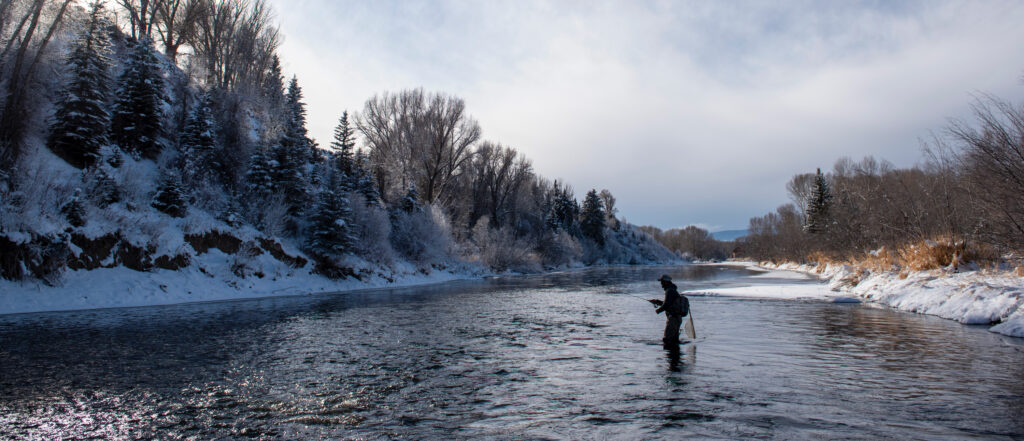
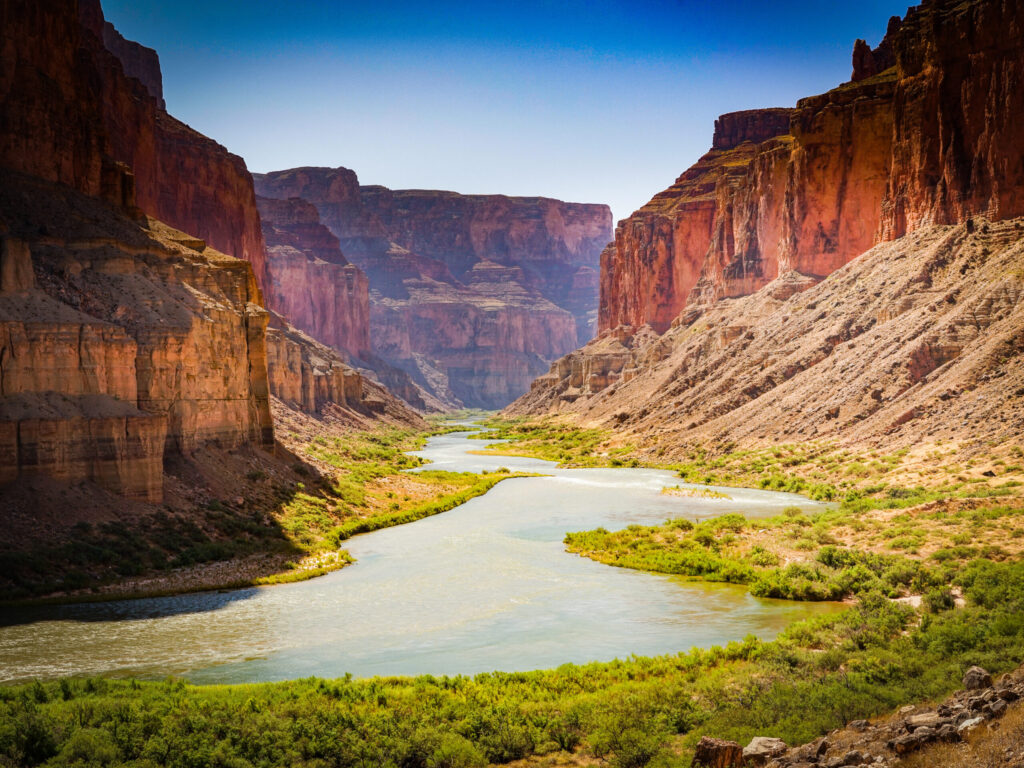

9 responses to “Celebrate! A Spring High Flow Experiment in Grand Canyon”
I was thrilled to come across your recent blog post titled “Celebrate a Spring High-Flow Experiment in Grand Canyon.” As an avid nature enthusiast and advocate for environmental conservation, I deeply appreciate the work you do to protect and preserve our precious waterways.
The Grand Canyon holds a special place in the hearts of many, and your efforts to celebrate and highlight the Spring High-Flow Experiment in this iconic location are commendable. These experiments play a vital role in restoring and maintaining the natural flow dynamics of the Colorado River, benefiting both the ecosystem and the countless species that depend on it.
I applaud your dedication to raising awareness about the importance of these high-flow experiments and the positive impact they have on the Grand Canyon’s ecosystem. The detailed information you provided about the experiment, including its purpose, duration, and the anticipated benefits for various species and habitats, is both educational and inspiring.
Furthermore, I appreciate the emphasis you placed on public involvement and engagement. Encouraging individuals to witness the high-flow experiment firsthand or participate in virtual experiences allows people to develop a deeper connection to the river and fosters a sense of stewardship for these natural treasures.
Your blog post serves as a valuable resource for anyone interested in learning more about the Spring High-Flow Experiment and its significance. By sharing this information, you are not only raising awareness but also empowering readers to support and advocate for the conservation of our rivers and the ecosystems they sustain.
Thank you for your tireless efforts in protecting and celebrating the Grand Canyon and its magnificent waterways. Your work is an inspiration to all who share a love for nature and a commitment to its preservation.
Thank you so much! Appreciate your interest and enthusiasm!!
I was thrilled to read about the Spring High-Flow Experiment in the Grand Canyon. It’s heartwarming to see organizations like yours taking proactive steps to protect and restore our natural waterways. The Grand Canyon holds a special place in the hearts of many, and initiatives like this demonstrate a commitment to its preservation.
The Spring High-Flow Experiment sounds like a remarkable endeavor. By releasing water from the Glen Canyon Dam, you’re mimicking the natural flooding that once occurred in the Colorado River, providing significant ecological benefits to the river and its surrounding ecosystem. The increase in flow will help restore critical habitats, replenish sandbars, and promote the growth of native plants, contributing to the overall health of the river corridor.
I appreciate the collaborative approach that your organization has taken by working with various stakeholders, including government agencies, Native American tribes, and conservation groups. Such partnerships are essential in achieving long-term success in conservation efforts. It’s heartening to see a shared commitment to preserving the natural beauty and ecological integrity of the Grand Canyon.
It’s also encouraging to learn about the scientific research and monitoring that will accompany the Spring High-Flow Experiment. Collecting data on the impacts of the increased flow will provide valuable insights into the river’s response and inform future management decisions. This evidence-based approach ensures that conservation efforts can be tailored to the specific needs of the ecosystem, maximizing their effectiveness.
I would like to commend American Rivers for its dedication to protecting our nation’s rivers and the incredible work being done in the Grand Canyon. Your efforts inspire others to appreciate the importance of safeguarding our natural treasures for generations to come. By highlighting success stories like the Spring High-Flow Experiment, you raise awareness and encourage more people to get involved in protecting and restoring our waterways.
Thank you for your commitment to conservation and for sharing this exciting news. I look forward to following the progress of the Spring High-Flow Experiment and the positive impact it will have on the Grand Canyon.
In 2013 we experienced one of these events. We checked with the rangers at Phantom Ranch to try to find about specifics. They said it might happen, but offered no details as to when. We did a layover at Pumpkin Springs and I took photos from very high up. Our boats were tied up about 50 feet down from a large flat rock shaped like a table, that we called sacrifice a virgin rock. We planned to get out early the next day and one member was to get us up. He got up to pee about 2:30 am and everything was OK, then went back to bed. About 4:30 we heard a calm voice saying, “get up people”, I replied we are awake and got out of my tent. Found the kitchen nearby with water flowing about 4″ under a roll-a-table. He had reached out of his tent and felt water, grabbed his tent and sleeping bag and threw them up the bank. I grabbed a tamarisk and fished his tent and sleeping bag out of the water and threw it up the bank. We wound up pulling the boats up 50 feet and tying them to big rocks above “sacrifice a virgin rock”. We lost an ammo can from the kitchen area. The water was way above Pumpkin Springs on the rocks. The water was loaded with whole trees that caused our kayaker to get into a raft to avoid collisions. We had a difficult time going our to Lake Mead the next day or two. The river was littered with water bottles and other rafting paraphernalia. The next year Pete, whose father was an old time surveyor, brought a measuring device that showed a vertical rise of 15 feet at Pumpkin Springs. We later heard that the release of 39.000 plus was accelerated to distract from some political event, but that was never confirmed.
Awesome! Great story! Thanks a bunch and thank you for your comment!
I was thrilled to read about the Spring High-Flow Experiment in the Grand Canyon. It’s heartening to see initiatives that prioritize the health and restoration of our natural waterways. The Grand Canyon is not only a national treasure but also an important ecosystem that deserves our utmost care and attention.
The Spring High-Flow Experiment, with its deliberate release of water from Glen Canyon Dam, serves multiple important purposes. It mimics the natural flooding events that used to occur before the dam’s construction, which helps rejuvenate the ecosystem and restore the ecological processes that rely on periodic high flows.
By simulating these natural flows, the experiment contributes to the improvement of riparian habitat, sediment replenishment, and the overall health of the river ecosystem. It is encouraging to see the collaboration between the Bureau of Reclamation, Grand Canyon National Park, and other stakeholders to undertake such an experiment with the aim of enhancing the long-term ecological integrity of the river.
This type of innovative and science-based approach to river management is crucial for the preservation and restoration of our waterways. It highlights the importance of balancing human water needs with the conservation of our natural ecosystems. The Spring High-Flow Experiment is a testament to the dedication of those involved in ensuring the sustainability of the Grand Canyon and its unique environment.
I commend the efforts of all those involved in planning and executing this experiment. The results and data collected from these initiatives will not only inform future decision-making but also contribute to our understanding of river ecosystems and the role they play in supporting biodiversity, recreation, and cultural heritage.
It is my hope that these collaborative efforts continue, and that more projects like the Spring High-Flow Experiment are undertaken in other river systems across the country. By valuing and protecting our rivers, we can ensure the long-term health and resilience of these precious natural resources.
Thank you for sharing this inspiring news and for your ongoing work in advocating for the protection and restoration of our rivers.
thank you
You’re welcome – thank you for reading!!
To conserve and save our rivers, our water ways the oceans is essential to the very planet itself💙🕊️💚🌎🕊️